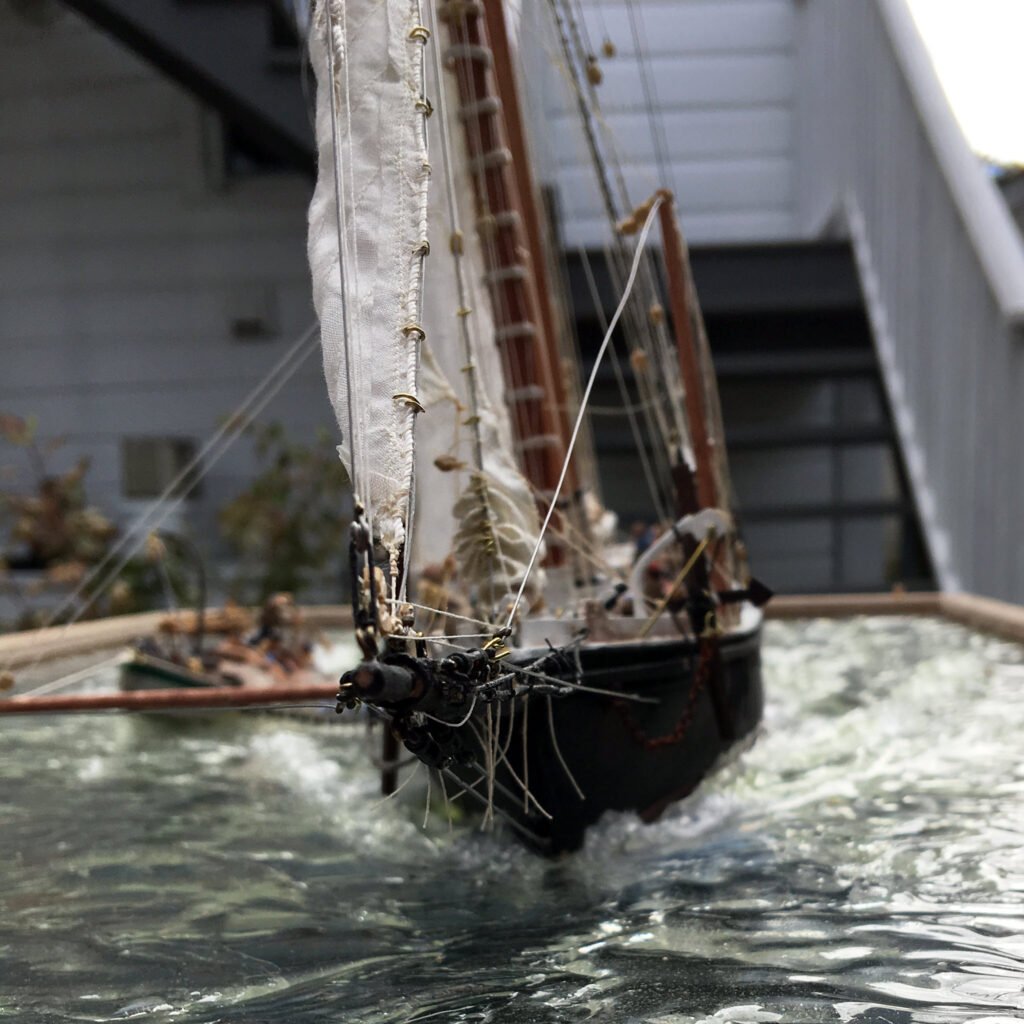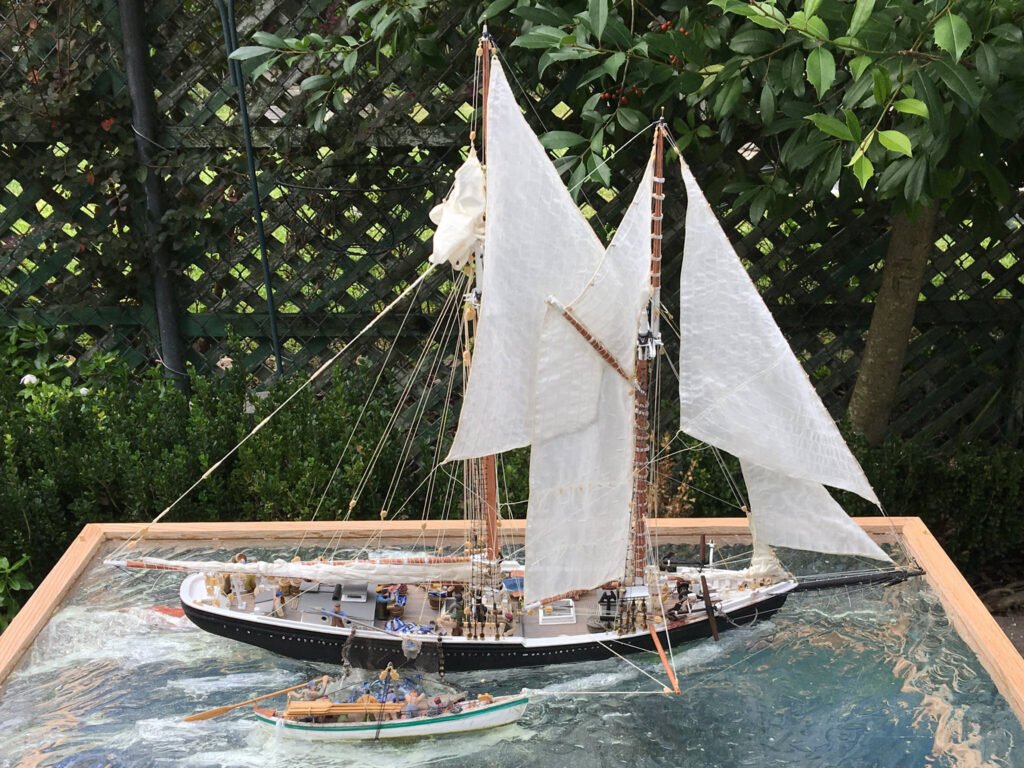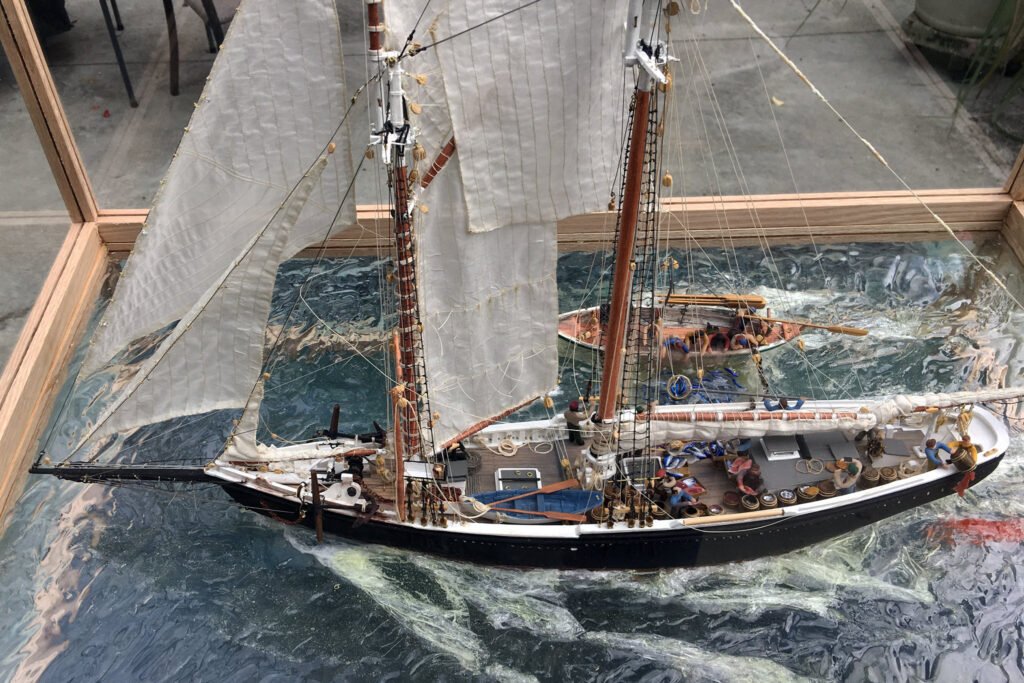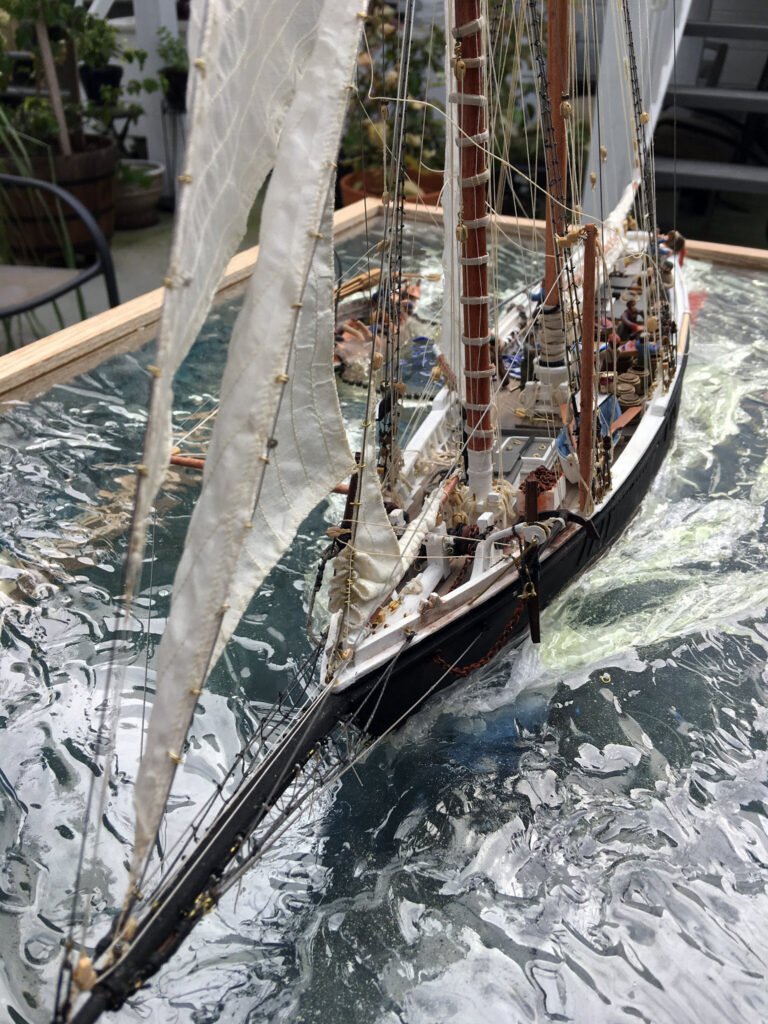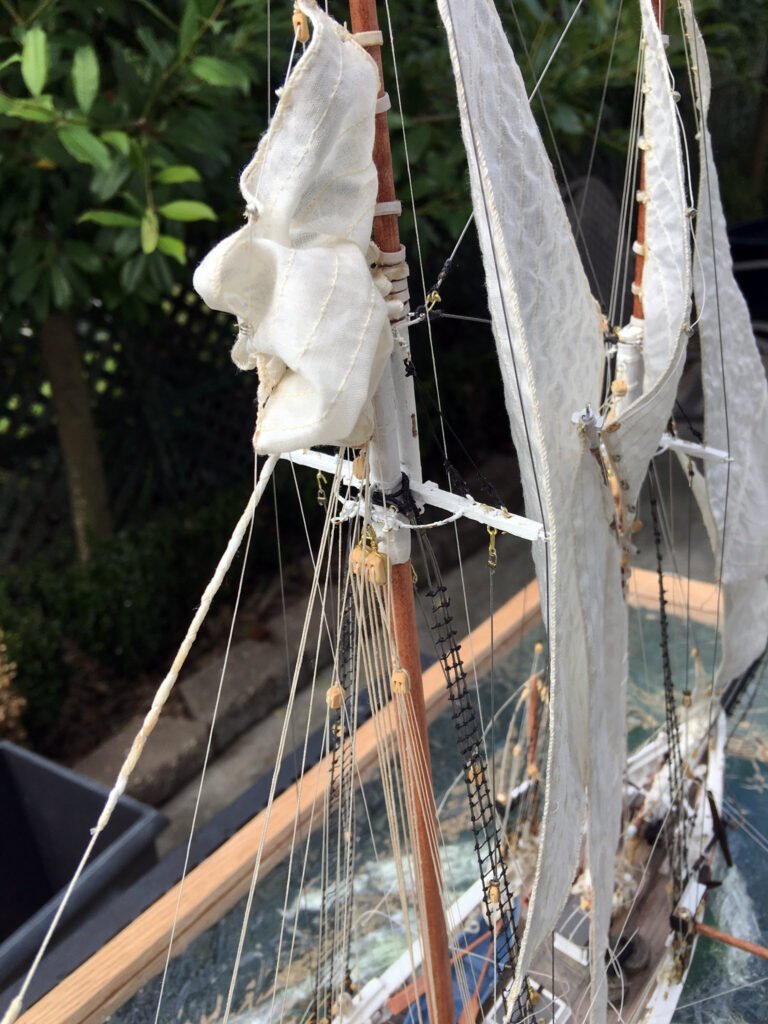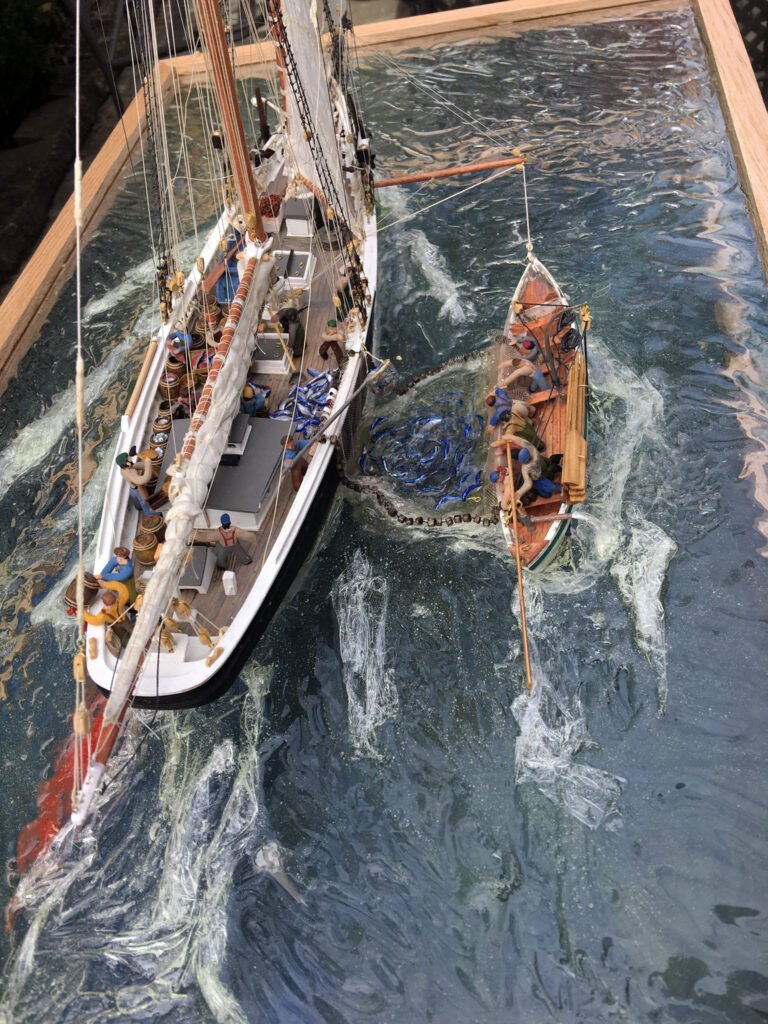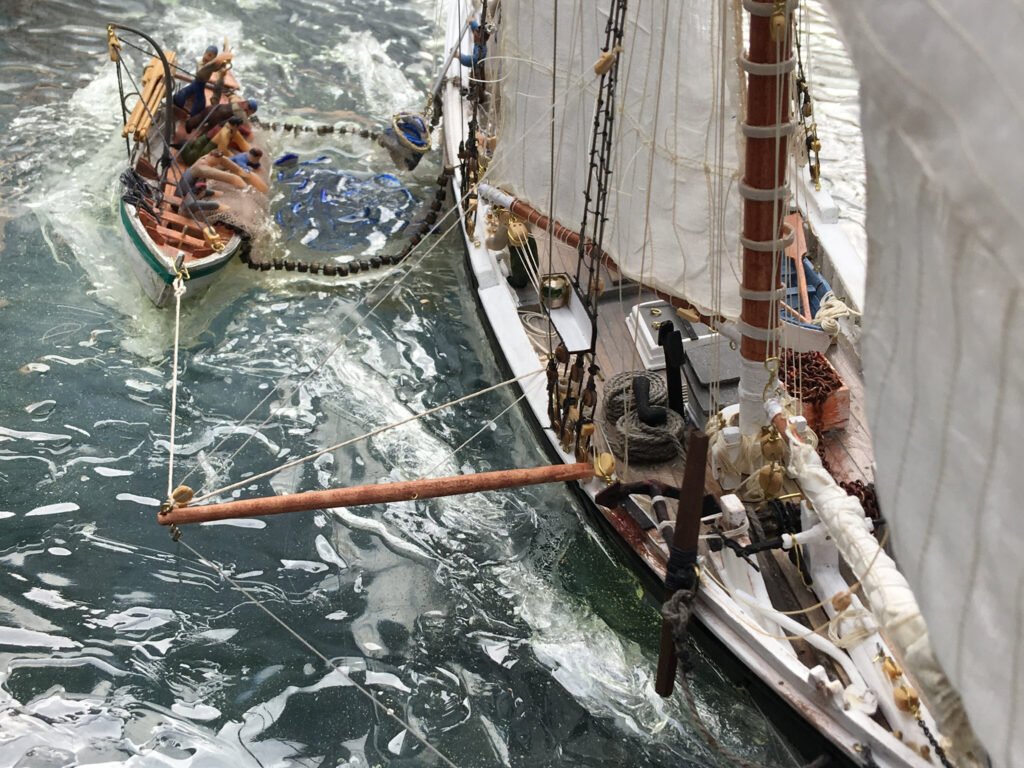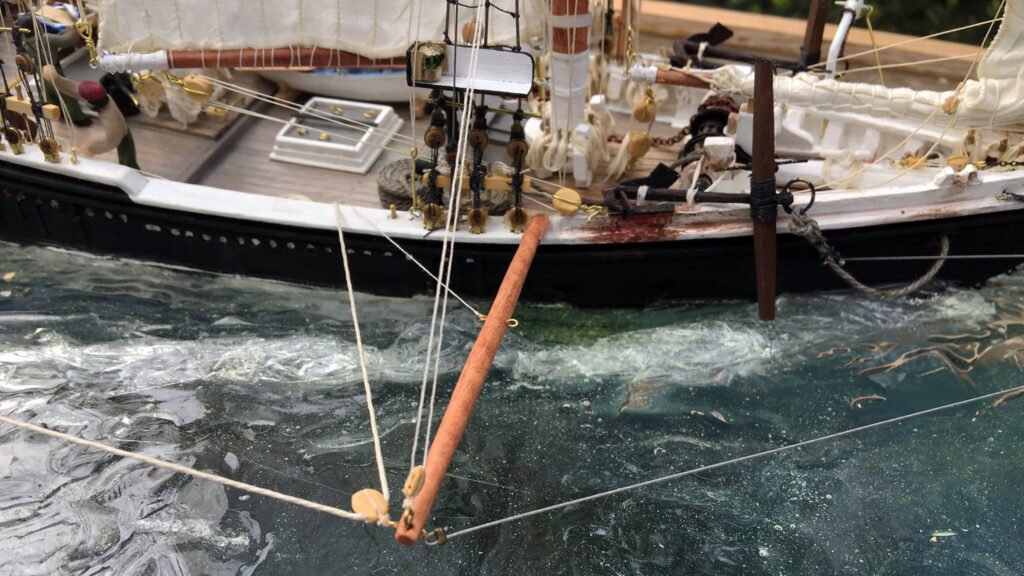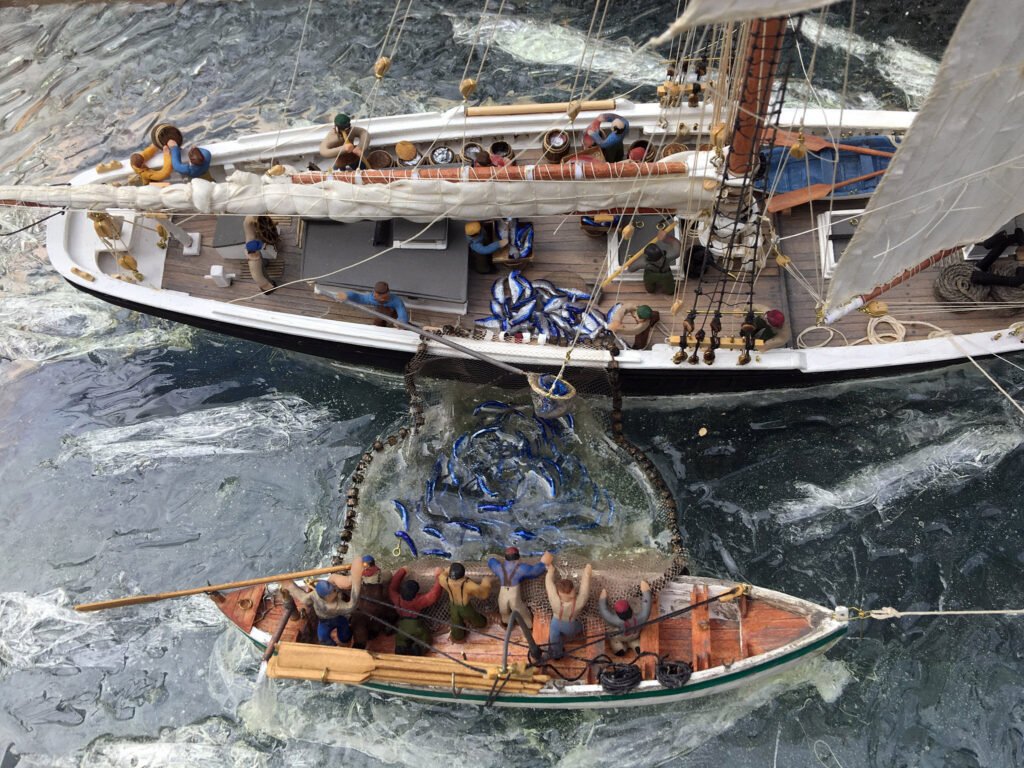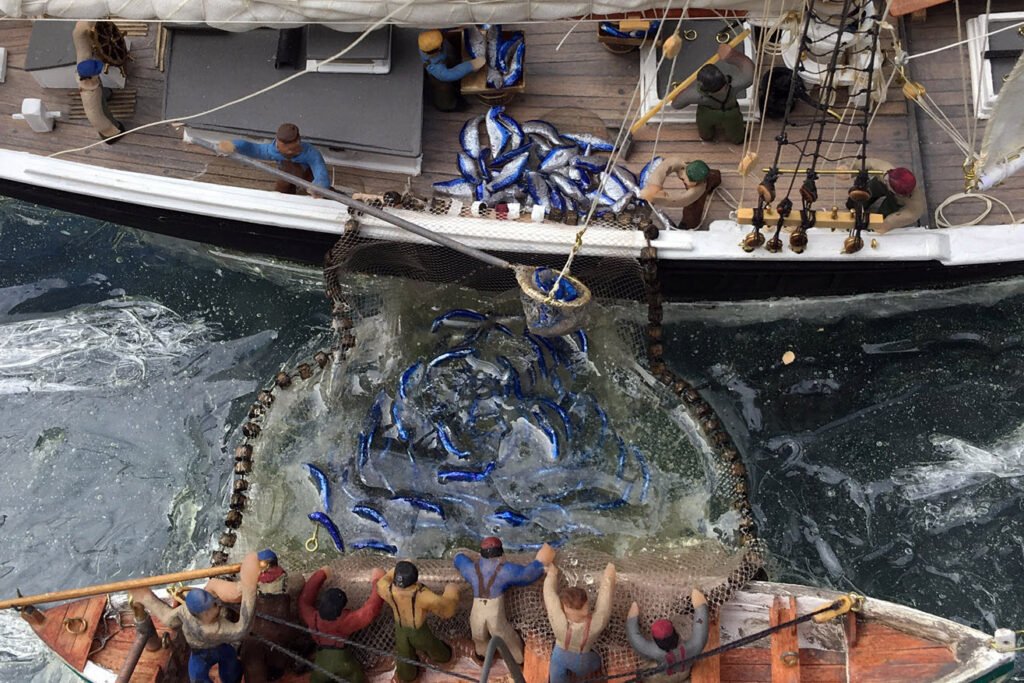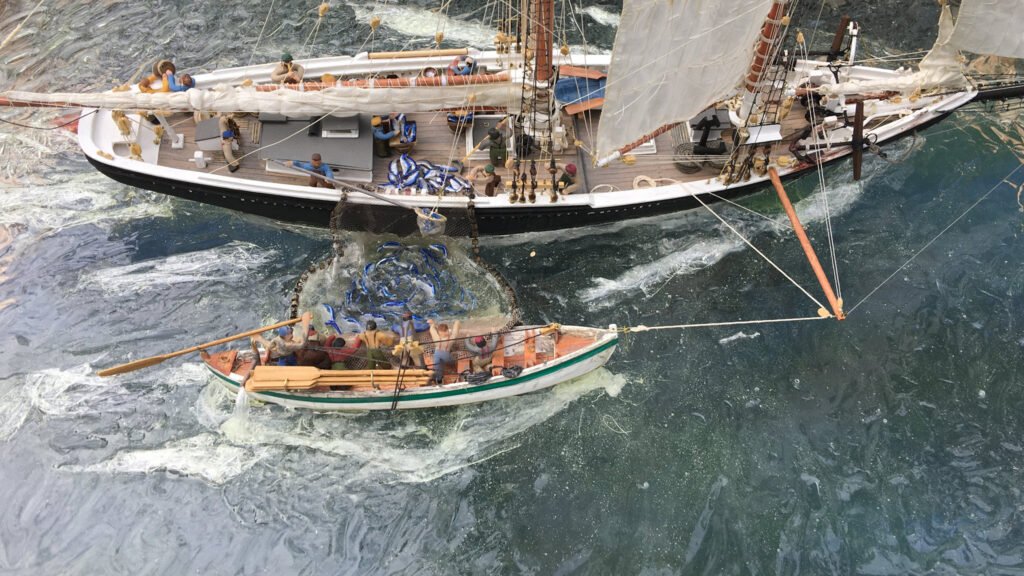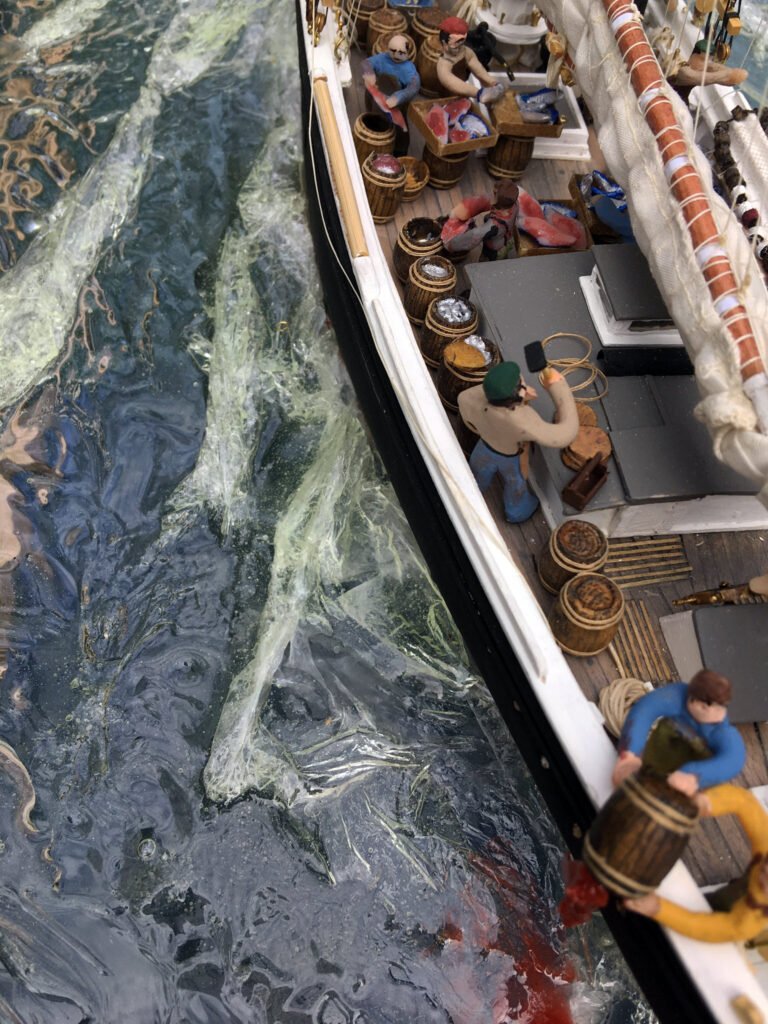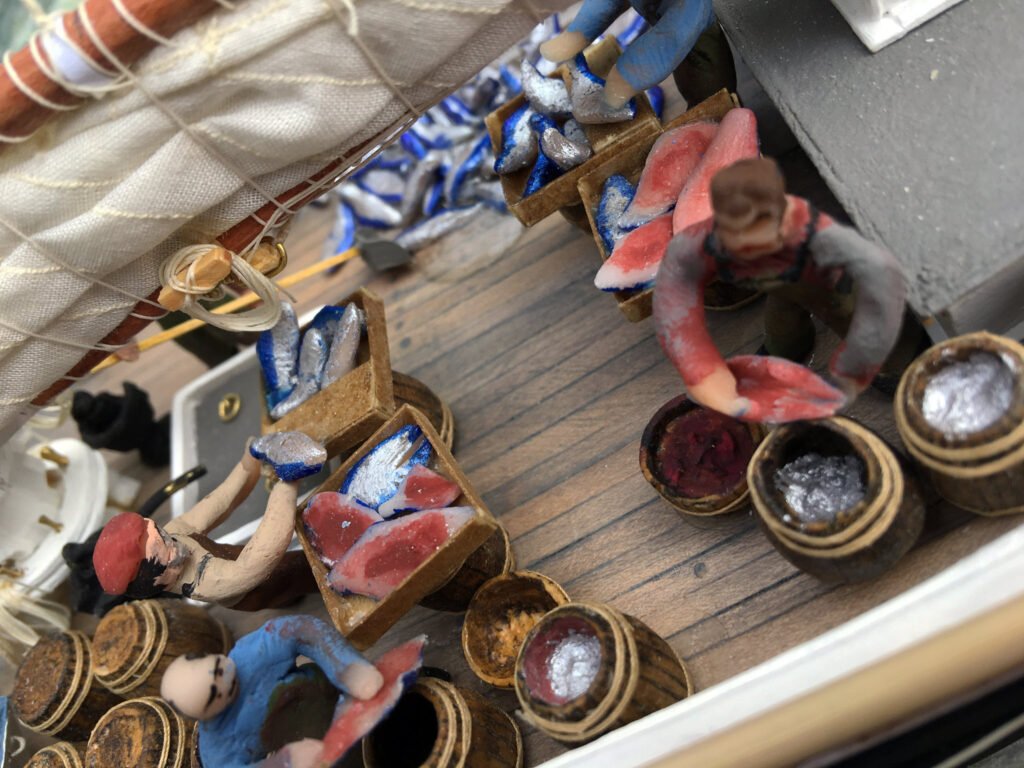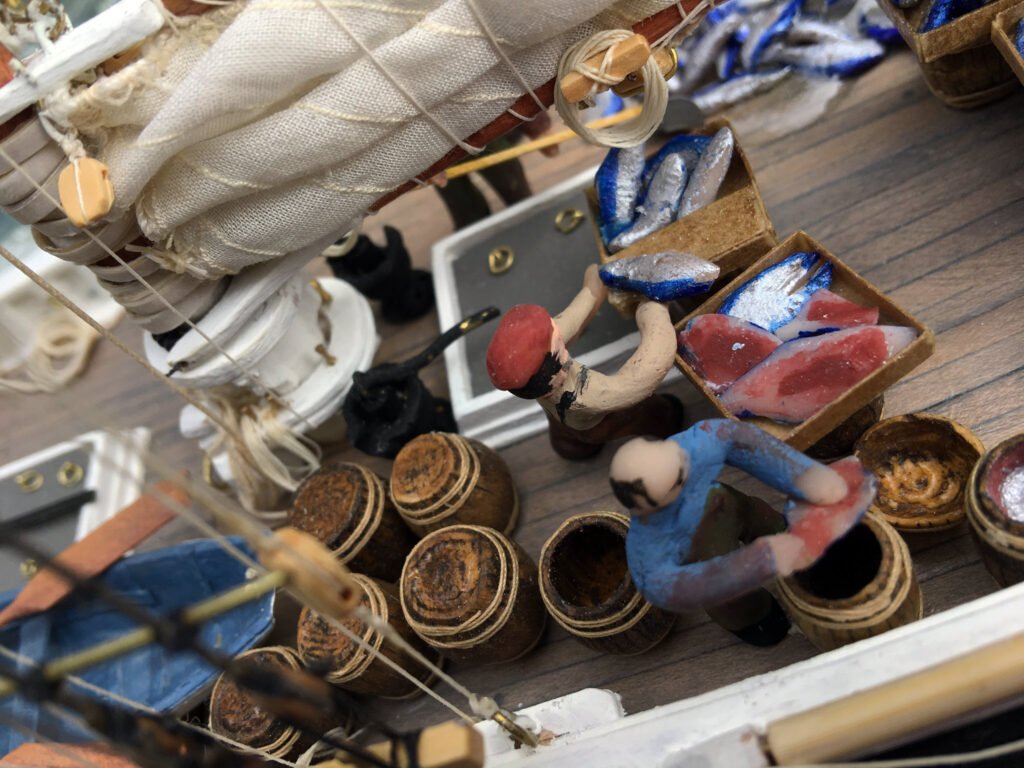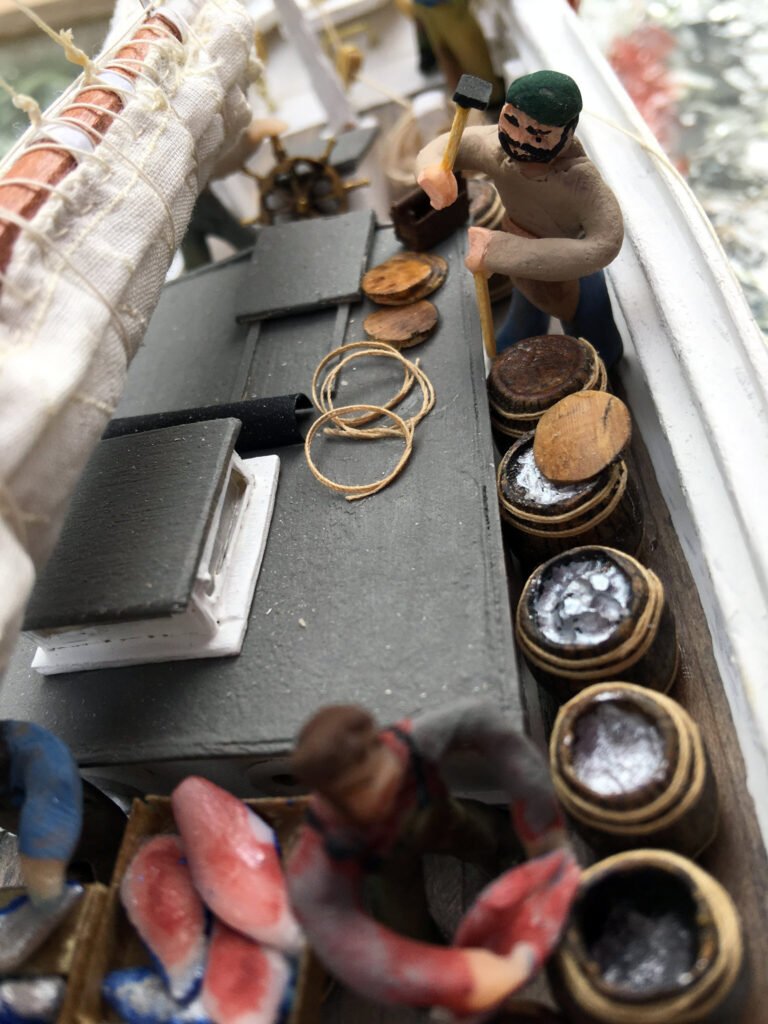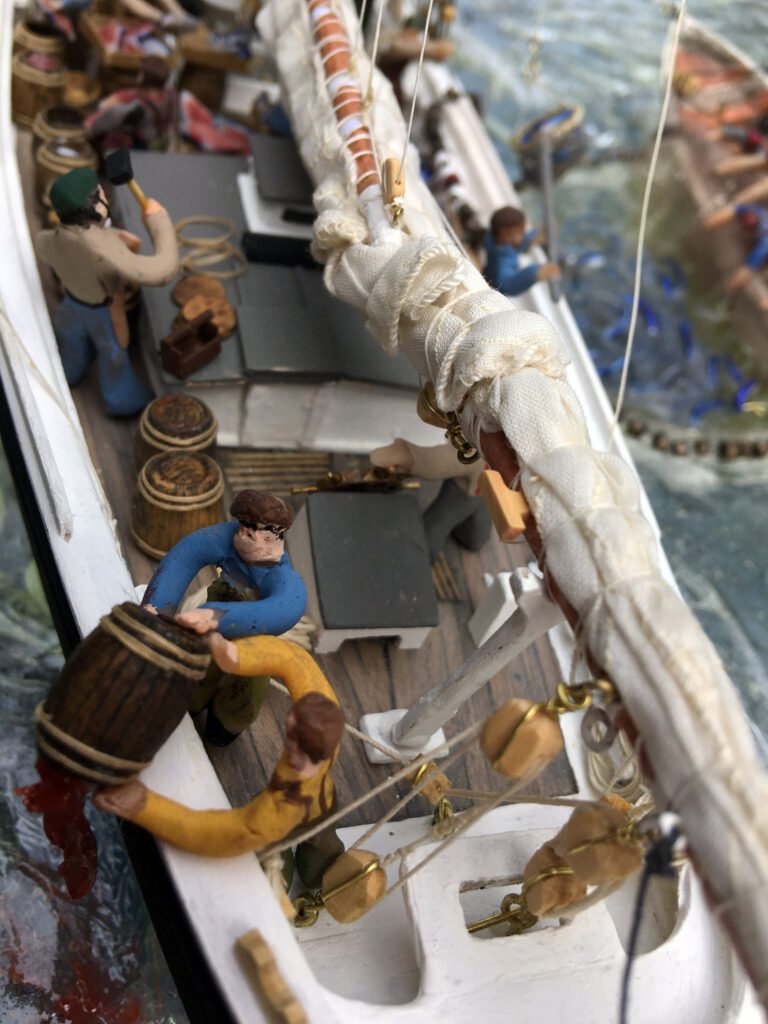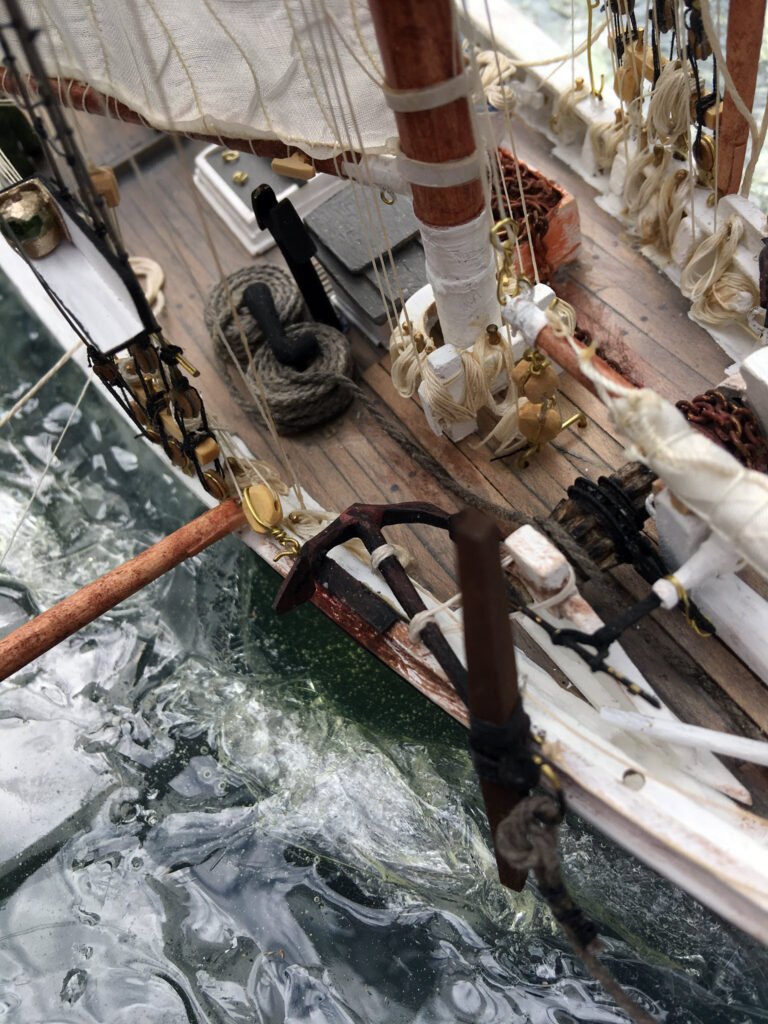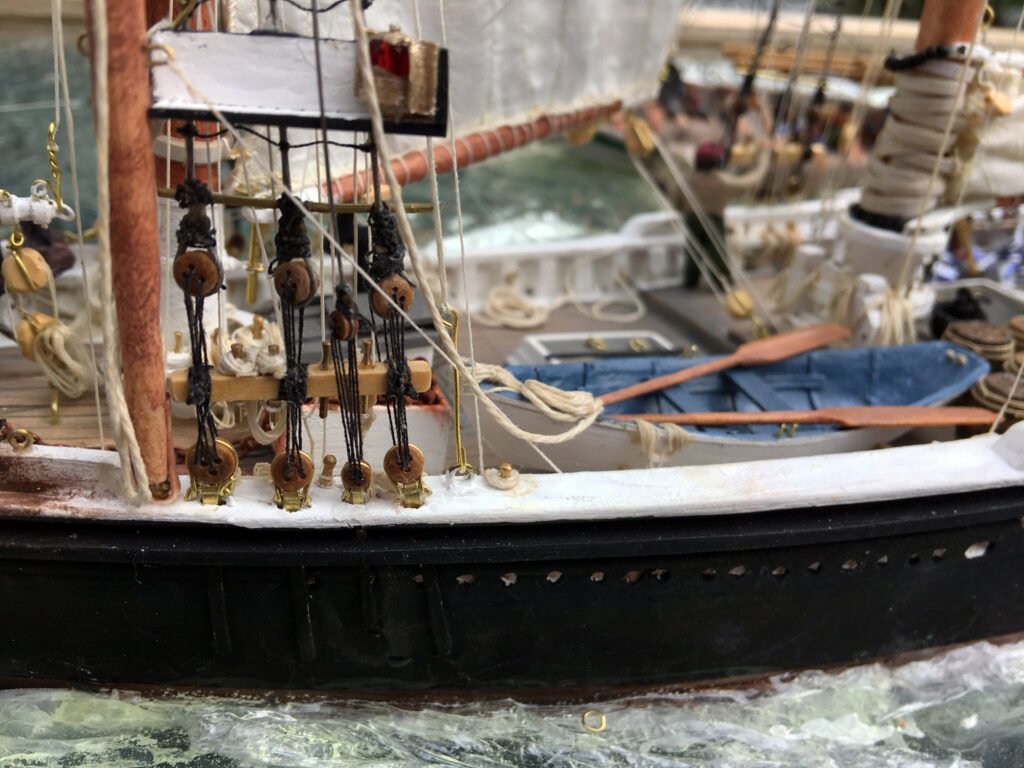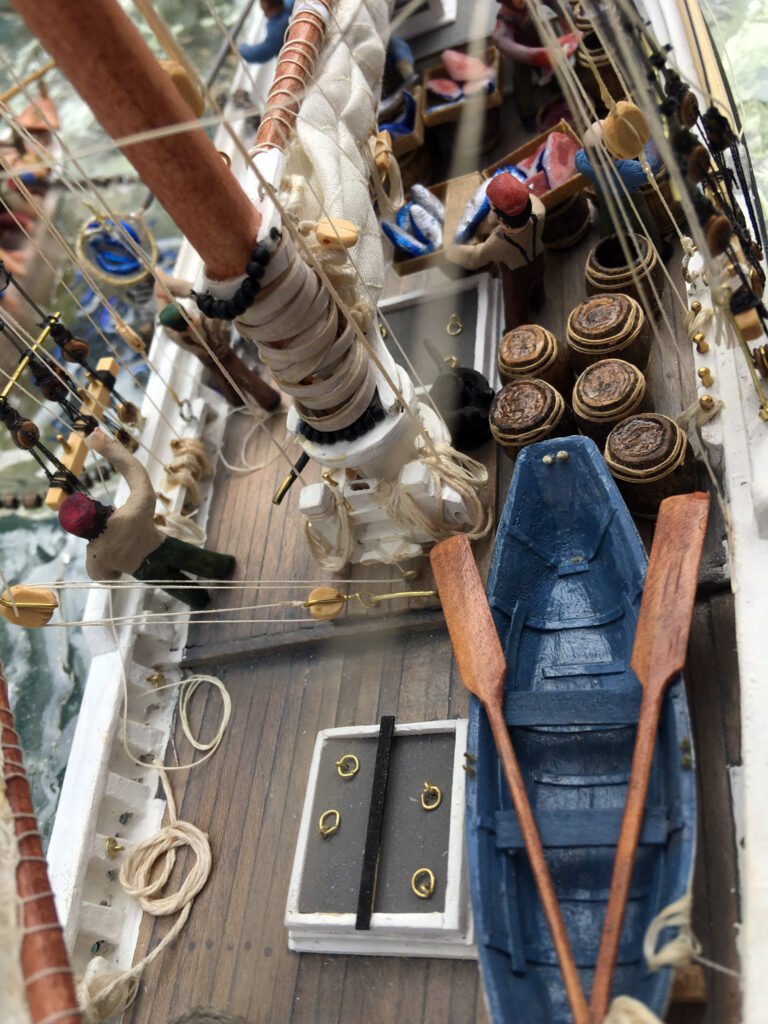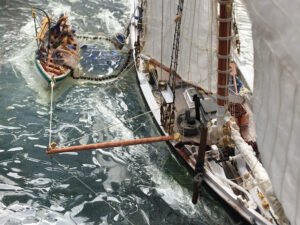
by Gene Andes
Categories:
- Build type: [Scratch]
- Material: [Wood]
- Scale: [1:64 (3/16" = 1')]
- Subject Type: [Fishing]
- Era: [1815-1914]
- Nationality: [United States]
- Propulsion: [Sail]
This model began as a 1:64 scale model of the Benjamin Latham (1902), a mackerel seiner designed by Thomas McManus, using the 1971 plans from Ronnberg, published by Model Shipways.
However, the plan soon evolved into a diorama showing the process of catching and stowing the mackerel. After building the anchor hoy and the Constitution shipyard, I wanted to combine what I had learned into another diorama showing a ship on the water going about its work with a full crew. The processes of seine fishing seemed an ideal subject.
I had completed the basic hull a few years ago, building it oak plank on oak frames. Once resurrected and back on the bench, I re-started the project with new purpose.
This model shows the ship with mainsail lowered and the main topsail clewed up. The “jumbo” jib is also furled. Foresail, foretopsail, inner and outer jibs, and the staysail are deployed. This configuration was suggested by several contemporary photographs of working vessels while processing the catch. I suspect the sails might not have been sheeted home but allowed to draw only partially, but were ready for use in the coming sprint back to the market.
The seine boat is being towed on the starboard (leeward) boom as the seine crew continues to haul the net into the boat. The seine boat has a small log pump in the after cuddy so the master of the boat can pump/bail out the water taken on with the net. The master also uses the steering oar to maintain working distance from the ship. The other oars are stowed in a metal rack on the side of the boat, out of the way as the crew hauls in the net.
The model shows the process mid-way through, with the seine area reduced as the net is hauled into the seine boat and the fish are dipped out and dropped on deck.
There are two teams, one keeler and one gibber in each, processing the fish.
As the barrels are filled with salted fish, the cooper works to seal them by adding the top and tightening the hoops. Full barrels are standing around the deck, awaiting stowage below deck, along with some empties awaiting fish.
Aft, on the portside, opposite the side of the seine, two crew empty a barrel of entrails, attracting a couple of sharks. Early reports from the seine fisheries described dogfish attaching the mackerel in the nets tearing holes in the netting and allowing the mackerel to escape. Later, use of heavier cordage for the nets prevented the problem. I thought the crew might scatter chum away from the net to attract shark elsewhere.
The case for the model is made of oak with acrylic glazing. The case separates at the waterline and the lower portion is also glazed with acrylic sheet with layers of tinted epoxy resin applied to the inside of the sides for a water effect and to the top surface of the top of the lower case to model the sea. This sheet is cut out for the ship and the seine boat which are cemented in place. The bottom of the lower case is plywood, painted a dark green with flat acrylic paint, which is then mottled with blues and black. The light entering the sides of the case is blued by the tinted epoxy on the sides so the color of the bottom, the deeper water, is a satisfactory teal color, modified by the light patterns through the distortion of the epoxy patterns.
The water surface is multiple layers of epoxy resin. I used a rapid setting resin and stirred it vigorously to entrain some air bubbles, added some tints, and stirred the surface as the resin cured to create wave patterns. The waves along the hull and the wakes were modeled using clear plastic wrap in the resin.
Here are some detail shots of the vessel. I did a little bit of weathering of the paint, and added some dirt and rust to make it look like a working boat.
I had to do a great deal of research to understand the process of mackerel seine fishing in the period of this model. Fortunately there was some information in the Model Shipways guide to building the model – the original guide, which included some excellent photographs taken in the early 20th century. I also downloaded a copy of the current manual, which does not contain the photos. An internet search turned up additional photos of fishing schooners, seine boats, crew, and details of the ships and of the processing of the catch in the days before refrigeration. Also, I found on line a .pdf of a government survey of the mackerel fishing industry from late 1800s. This document included an inventory of vessels active in several of the fisheries over several years, including name and tonnage of the vessels. It also contained a detailed description of the fishing methods, both seine fishing and hook-line fishing, as well as description of the cleaning and stowing of the catch.
The crew activities depicted in the model are based on the description in the above report and photographs found on line and in the Model Shipways 1972 manual.
The Latham was a small schooner, not large enough to carry the seine boat on board, so she towed the boat beside her out and back to the fishing banks. The seine net itself, a “purse seine”, was carried on deck and transferred over the “seine roller” on the after port side of the ship to the seine boat upon arrival at the fishery.
The lookout at the mast head kept watch for signs of mackerel, which school in large numbers near the surface so create a visible surface disturbance. Once a likely catch was spotted, the crew of the seine boat (8 to 10 men) and the two men in the dory deployed the seine around the school of fish.
Once the fish were encircled, crew transferred the two ends of the seine net to the seine boat, signaled the ship to come alongside, and the dory returned to the ship taking some of the seine boat crew also back to the ship. The purse lines, which were along the weighted bottom of the seine (the upper edge of the seine was suspended from floating corks) then could be tightened to close the bottom by hauling them onboard the seine boat through a system of blocks and a “purse davit”.
Sometimes, when the seine was being deployed, the captain conned the seine boat, with the cook at the helm of the ship the only man on board, but the captain returned to the ship once the seine was closed.
Once the dory was stowed on deck, the ship then drew alongside the seine boat, which was secured to a towing boom on the starboard side of the ship. The side of the seine opposite the formerly open end was a rectangular extension, known as the bail, which was marked by red and white painted corks. The section was hauled on board the ship and secured to a board fastened to the bulwark on the starboard side as the men on the seine boat hauled the seine onboard to progressively shrink the size of the seine as the catch was hauled on board the ship for processing.
The seine was emptied using a large dip net, suspended from a dory tackle on the main cross tree, starboard side, and guided by a second crewman using its long handle. The mackerel were dipped out and the net emptied onto the deck in a mass of flopping fish and flying scales.
The mackerel were first opened up along the backbone by the “keeler”, who then passed the fish to the “gibber”, who removed the entrails before depositing the fish into a barrel containing brine. The Keeler and Gibber generally worked over open boxes standing on barrels to make a working table, or placed the boxes onto the cabin roof. The boxes held the fish to be processed. A crewman shoveled or netted fish into the box of the keeler, who passed the opened fish to the box of the gibber. Sometimes salt was added to the gibber’s box or more often added to the fish when, after removal of entrails, the gibber put the fish into the barrel.
Once a barrel was full of fish, it was passed to the cooper, who placed a lid on the barrel and fastened it by driving the barrel hoops down to tighten the staves. The barrels usually had hoops made of saplings with ends twisted under and secured by a tap. There was also often a bung to permit opening the bunghole to add salt or brine.
Filled barrels accumulated on deck and were later transferred to the hold for the speedy voyage back home. Depending on the size of the vessel and the size of the catch, hundreds to over a thousand barrels might be transported back. If a vessel was particularly fortunate, and the mackerel catch exceeded its capacity, the captain might fly a signal for other ships to lay alongside to share the catch, on shares, of course.
- Page for this model on the modelmaker’s personal website
- Model of Benjamin W. Latham by HRSMS member Bob Comet
- Model of Benjamin W. Latham by HRSMS member Stewart Winn
- Model of Benjamin W. Latham by HRSMS member George Livingston

